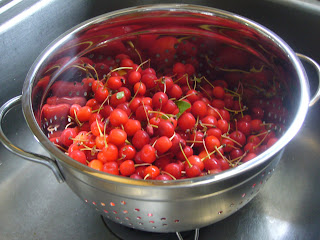In years past, larder was the common term for a pantry or cellar; a cool place to store food. Then with refrigeration and an abundance of grocery stores, families lost the practice of stocking the larder. Well, I believe, with a desire to know where our food comes from, to provide nutritious homemade food and with concern over economic uncertainties, the larder, or pantry, is making a come back. I like to think so anyway.
When we strive to make homemade meals from scratch, having a well-stocked pantry is essential. When I come home from work and begin to cook, if I don't have some of the ingredients on hand, I do not have time to run to the store, then I have to come up with something else to make for dinner. Switching plans at the last minute takes unnecessary time out of a busy schedule and is frustrating, not the way you want to start your evening

Keeping a well-stocked pantry can save money. It is said that the more times we are in a grocery store the more money we spend on groceries since we usually pick up something else that we didn't plan to buy. I have done this, it is usually a snack item, or some other unnecessary purchase. Stocking up on an item that you eat often while it is on sale also saves money in the long run. Canning what you grow or what is in season at a good price is another way to save money. It also means we are less likely to go out to eat or call for a pizza, saving us money that way as well.

Another concern for us, and the reason we stock up on all ingredients in the fall, is the weather. We have storms and blizzards that can make it impossible to get to the store or just miserable to have to run to the store on lunch break or after work. Last winter we had a two day blizzard and couldn't get out until late on the third day. We ran out of butter during the storm, I had cream so I could make my own, but that was a good reminder to watch closer what I have available. Keep a close eye on what you have on hand, make a shopping list by going to the pantry, refrigerator and freezer.
Cooking from scratch and eating homemade meals not only saves money, it is much healthier for us, something we all need to be concerned about. Eating real food with ingredients we recognize is better for the overall well-being and waistlines of our family and ourselves.
The photo above shows some pint jars of rhubarb sauce I made and canned last Friday evening. The rhubarb is not the pretty red it was in the spring, but it still has very good flavor. This is the last rhubarb I will pick this year, now I need to let the plant grow so that it will be a healthy, strong plant next year.
I have been gathering herbs to add to my pantry as well. Here are basil and thyme drying, once dried the leaves will be placed in mason jars and stored in a cool dry place. They will add flavor and nutrients to our dishes this winter. I plan to bring my potted herbs in the house this fall, but if they don't survive the adjustment to indoor life, I will have the dried herbs to use in cooking.

A pantry can and should be built slowly over time. No need to have a lot of money to fill the shelves in one shopping trip. Gradually add the produce in your garden by canning, drying, and freezing as it becomes ripe. Purchase produce you can't grow, or grow enough of, while in season and at a good price; chances are it hasn't had to travel as far to get to your kitchen then either. Look at what you are eating on a regular basis and watch for sales on those items or gradually add an extra can or two a week until you have enough to last several months. One caution though, be sure to watch the expiration dates, using the oldest first and don't buy more than you can resonably eat before the product expires.



















